Non-Destructive Diagnostics of Concrete Beams Strengthened with Steel Plates Using Modal Analysis and Wavelet Transform
Abstract
1. Introduction
2. Materials and Methods
2.1. Object of Research
2.2. Experimental Procedure
2.3. Numerical Modelling
2.4. Continuous Wavelet Transform for Mode Shape Processing
3. Results and Discussion
3.1. Modal Analysis—Natural Mode Shapes
3.2. Wavelet Transform-Based Damage Imaging
4. Conclusions
- The consistency between experimental and numerical eigenfrequencies and mode shapes confirmed the propriety of the performed experimental measurements and numerical simulations. The decrease of the natural frequency with the increasing size of the damaged area was observed.
- The interpretation of experimental and numerical mode shapes for all analyzed beams allowed initial damage detection by revealing significant disturbances connected with the presence of debonding areas.
- The comparison between conventional derivatives and continuous wavelet transforms for numerical results revealed the advantages of the latter. Both approaches gave consistent information about the damage; however, the CWT maps were more useful because of showing the defects more precisely.
- The appropriate choice of CWT calculation parameters is essential for the efficiency of obtained damage visualization. The quality of damage maps increased with the number of vanishing moments of the applied Gaussian wavelets. Low order of wavelet could lead to incorrect detection of defects in intact beams. In the case of scales, too high values could result in indistinct damage imaging, on the other hand, too low ones could reveal noise of signals.
- A good agreement between experimental and numerical CWT maps was observed for the data collected with coarse mesh (with a grid of 20 mm). However, the determination of the exact size of the smallest defect was not possible. The interpolation of the data allowed enhancing the quality of the obtained numerical damage maps. On the other hand, the experimental results had a poorer quality, because of the noise contained in the measured signals. The increase in scale helped overcome this difficulty.
- In general, the interpolation of the collected data can allow reducing the number of measurements. However, the coarse mesh grid can make the small defects undetectable. Furthermore, interpolation of experimental results can lead to the distortion of damage shape in CWT maps, especially for higher-order wavelets.
Author Contributions
Funding
Institutional Review Board Statement
Informed Consent Statement
Data Availability Statement
Acknowledgments
Conflicts of Interest
References
- Giurgiutiu, V.; Lyons, J.; Petrou, M.; Laub, D.; Whitley, S. Fracture mechanics testing of the bond between composite overlays and a concrete substrate. J. Adhes. Sci. Technol. 2001, 15, 1351–1371. [Google Scholar] [CrossRef]
- Napoli, A.; Realfonzo, R. Reinforced concrete beams strengthened with SRP/SRG systems: Experimental investigation. Constr. Build. Mater. 2015, 93, 654–677. [Google Scholar] [CrossRef]
- Czaderski, C.; Meier, U. EBR Strengthening Technique for Concrete, Long-Term Behaviour and Historical Survey. Polymers 2018, 10, 77. [Google Scholar] [CrossRef]
- Batti, M.M.B.; do Vale Silva, B.; Piccinini, Â.C.; dos Santos Godinho, D.; Antunes, E.G.P. Experimental Analysis of the Strengthening of Reinforced Concrete Beams in Shear Using Steel Plates. Infrastructures 2018, 3, 52. [Google Scholar] [CrossRef]
- Schabowicz, K. Non-Destructive Testing of Materials in Civil Engineering. Materials 2019, 12, 3237. [Google Scholar] [CrossRef]
- Rucka, M. Special Issue: “Non-Destructive Testing of Structures”. Materials 2020, 13, 4996. [Google Scholar] [CrossRef] [PubMed]
- Sen, R. Developments in the durability of FRP-concrete bond. Constr. Build. Mater. 2015, 78, 112–125. [Google Scholar] [CrossRef]
- Lai, W.L.; Lee, K.K.; Kou, S.C.; Poon, C.S.; Tsang, W.F. A study of full-field debond behaviour and durability of CFRP-concrete composite beams by pulsed infrared thermography (IRT). NDT E Int. 2012, 52, 112–121. [Google Scholar] [CrossRef]
- Tashan, J.; Al-Mahaidi, R. Bond defect detection using PTT IRT in concrete structures strengthened with different CFRP systems. Compos. Struct. 2014, 111, 13–19. [Google Scholar] [CrossRef]
- Yazdani, N.; Beneberu, E.; Riad, M. Nondestructive Evaluation of FRP-Concrete Interface Bond due to Surface Defects. Adv. Civ. Eng. 2019, 2019, 2563079. [Google Scholar] [CrossRef]
- Gu, J.C.; Unjoh, S.; Naito, H. Detectability of delamination regions using infrared thermography in concrete members strengthened by CFRP jacketing. Compos. Struct. 2020, 245, 112328. [Google Scholar] [CrossRef]
- Steinbild, P.J.; Höhne, R.; Füßel, R.; Modler, N. A sensor detecting kissing bonds in adhesively bonded joints using electric time domain reflectometry. NDT E Int. 2019, 102, 114–119. [Google Scholar] [CrossRef]
- Song, H.; Popovics, J.S. Characterization of steel-concrete interface bonding conditions using attenuation characteristics of guided waves. Cem. Concr. Compos. 2017, 83, 111–124. [Google Scholar] [CrossRef]
- Li, J.; Lu, Y.; Guan, R.; Qu, W. Guided waves for debonding identification in CFRP-reinforced concrete beams. Constr. Build. Mater. 2017, 131, 388–399. [Google Scholar] [CrossRef]
- Rucka, M. Failure Monitoring and Condition Assessment of Steel-Concrete Adhesive Connection Using Ultrasonic Waves. Appl. Sci. 2018, 8, 320. [Google Scholar] [CrossRef]
- Wojtczak, E.; Rucka, M. Wave frequency effects on damage imaging in adhesive joints using lamb waves and RMS. Materials 2019, 12, 1842. [Google Scholar] [CrossRef]
- Wojtczak, E.; Rucka, M.; Knak, M. Detection and imaging of debonding in adhesive joints of concrete beams strengthened with steel plates using guided waves and weighted root mean square. Materials 2020, 13, 2167. [Google Scholar] [CrossRef]
- Doebling, S.W.; Farrar, C.R.; Prime, M.B.; Shevitz, D.W. Damage identification and health monitoring of structural and mechanical systems from changes in their vibration characteristics: A literature review. Los Alamos Natl. Lab. Rep. 1996, 249299. [Google Scholar] [CrossRef]
- Sohn, H.; Farrar, C.R.; Hemez, F.; Czarnecki, J. A Review of Sstructural Health Monitoring Literature 1996–2001. Los Alamos Natl. Lab. Rep. 2003, 976152. [Google Scholar]
- Salawu, O.S. Detection of structural damage through changes in frequency: A review. Eng. Struct. 1997, 19, 718–723. [Google Scholar] [CrossRef]
- Fan, W.; Qiao, P. Vibration-based damage identification methods: A review and comparative study. Struct. Health Monit. 2011, 10, 83–111. [Google Scholar] [CrossRef]
- Hou, R.; Xia, Y. Review on the new development of vibration-based damage identification for civil engineering structures: 2010–2019. J. Sound Vib. 2021, 491, 115741. [Google Scholar] [CrossRef]
- Kim, J.T.; Stubbs, N. Crack detection in beam-type structures using frequency data. J. Sound Vib. 2003, 259, 145–160. [Google Scholar] [CrossRef]
- Zhang, Y.; Wang, L.; Lie, S.T.; Xiang, Z. Damage detection in plates structures based on frequency shift surface curvature. J. Sound Vib. 2013, 332, 6665–6684. [Google Scholar] [CrossRef]
- Dessi, D.; Camerlengo, G. Damage identification techniques via modal curvature analysis: Overview and comparison. Mech. Syst. Signal Process. 2015, 52–53, 181–205. [Google Scholar] [CrossRef]
- Radzieński, M.; Krawczuk, M.; Palacz, M. Improvement of damage detection methods based on experimental modal parameters. Mech. Syst. Signal Process. 2011, 25, 2169–2190. [Google Scholar] [CrossRef]
- Makki Alamdari, M.; Li, J.; Samali, B. Damage identification using 2-D discrete wavelet transform on extended operational mode shapes. Arch. Civ. Mech. Eng. 2015, 15, 698–710. [Google Scholar] [CrossRef]
- Yang, C.; Oyadiji, S.O. Damage detection using modal frequency curve and squared residual wavelet coefficients-based damage indicator. Mech. Syst. Signal Process. 2017, 83, 385–405. [Google Scholar] [CrossRef]
- Swamy, S.; Reddy, D.M.; Prakash, G.J. Damage detection and identification in beam structure using modal data and wavelets. World J. Model. Simul. 2017, 13, 52–65. [Google Scholar]
- Janeliukstis, R.; Rucevskis, S.; Wesolowski, M.; Chate, A. Experimental structural damage localization in beam structure using spatial continuous wavelet transform and mode shape curvature methods. Meas. J. Int. Meas. Confed. 2017, 102, 253–270. [Google Scholar] [CrossRef]
- Gentile, A.; Messina, A. On the continuous wavelet transforms applied to discrete vibrational data for detecting open cracks in damaged beams. Int. J. Solids Struct. 2003, 40, 295–315. [Google Scholar] [CrossRef]
- Loutridis, S.; Douka, E.; Trochidis, A. Crack identification in double-cracked beams using wavelet analysis. J. Sound Vib. 2004, 277, 1025–1039. [Google Scholar] [CrossRef]
- Rucka, M.; Wilde, K. Application of continuous wavelet transform in vibration based damage detection method for beams and plates. J. Sound Vib. 2006, 297, 536–550. [Google Scholar] [CrossRef]
- Rucka, M. Damage detection in beams using wavelet transform on higher vibration modes. J. Theor. Appl. Mech. 2011, 49, 399–417. [Google Scholar]
- Pacheco-Chérrez, J.; Delgado-Gutiérrez, A.; Cárdenas, D.; Probst, O. Reliable damage localization in cantilever beams using an image similarity assessment method applied to wavelet-enhanced modal analysis. Mech. Syst. Signal Process. 2021, 149. [Google Scholar] [CrossRef]
- Katunin, A.; Araújo dos Santos, J.V.; Lopes, H. Damage identification by wavelet analysis of modal rotation differences. Structures 2021, 30, 1–10. [Google Scholar] [CrossRef]
- Katunin, A. Damage identification in composite plates using two-dimensional B-spline wavelets. Mech. Syst. Signal Process. 2011, 25, 3153–3167. [Google Scholar] [CrossRef]
- Fan, W.; Qiao, P. A 2-D continuous wavelet transform of mode shape data for damage detection of plate structures. Int. J. Solids Struct. 2009, 46, 4379–4395. [Google Scholar] [CrossRef]
- Katunin, A. Nondestructive damage assessment of composite structures based on wavelet analysis of modal curvatures: State-of-the-art review and description of wavelet-based damage assessment benchmark. Shock Vib. 2015, 2015. [Google Scholar] [CrossRef]
- Grębowski, K.; Rucka, M.; Wilde, K. Non-Destructive Testing of a Sport Tribune under Synchronized Crowd-Induced Excitation Using Vibration Analysis. Materials 2019, 12, 2148. [Google Scholar] [CrossRef] [PubMed]
- Chróścielewski, J.; Miśkiewicz, M.; Pyrzowski, Ł.; Rucka, M.; Sobczyk, B.; Wilde, K. Modal properties identification of a novel sandwich footbridge–Comparison of measured dynamic response and FEA. Compos. Part B Eng. 2018, 151, 245–255. [Google Scholar] [CrossRef]
- Mallat, S. A Wavelet Tour of Signal Processing: The Sparse Way; Elsevier/Academic Press: Burlington, VT, USA, 2009; ISBN 9780123743701. [Google Scholar]
- Misiti, M.; Misiti, Y.; Oppenheim, G.; Poggi, J.-M. Wavelet ToolboxTM User’s Guide; The MathWorks, Inc.: Natick, MA, USA, 2020. [Google Scholar]
- MATLAB; Ver. 2020b, 9.9.0.1570001; Programming and Numeric Computing Platform; The MathWorks: Natick, MA, USA, 2020.
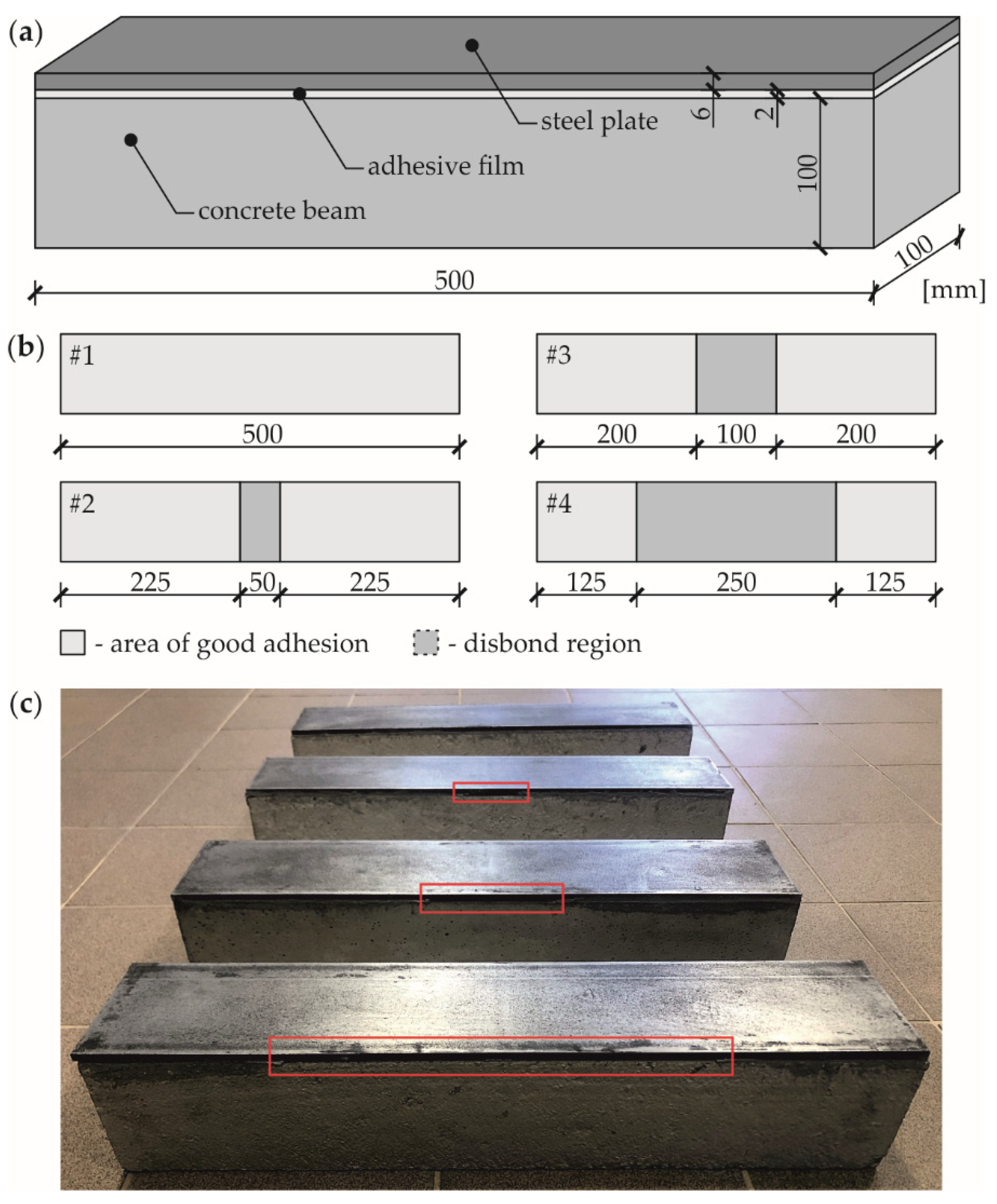
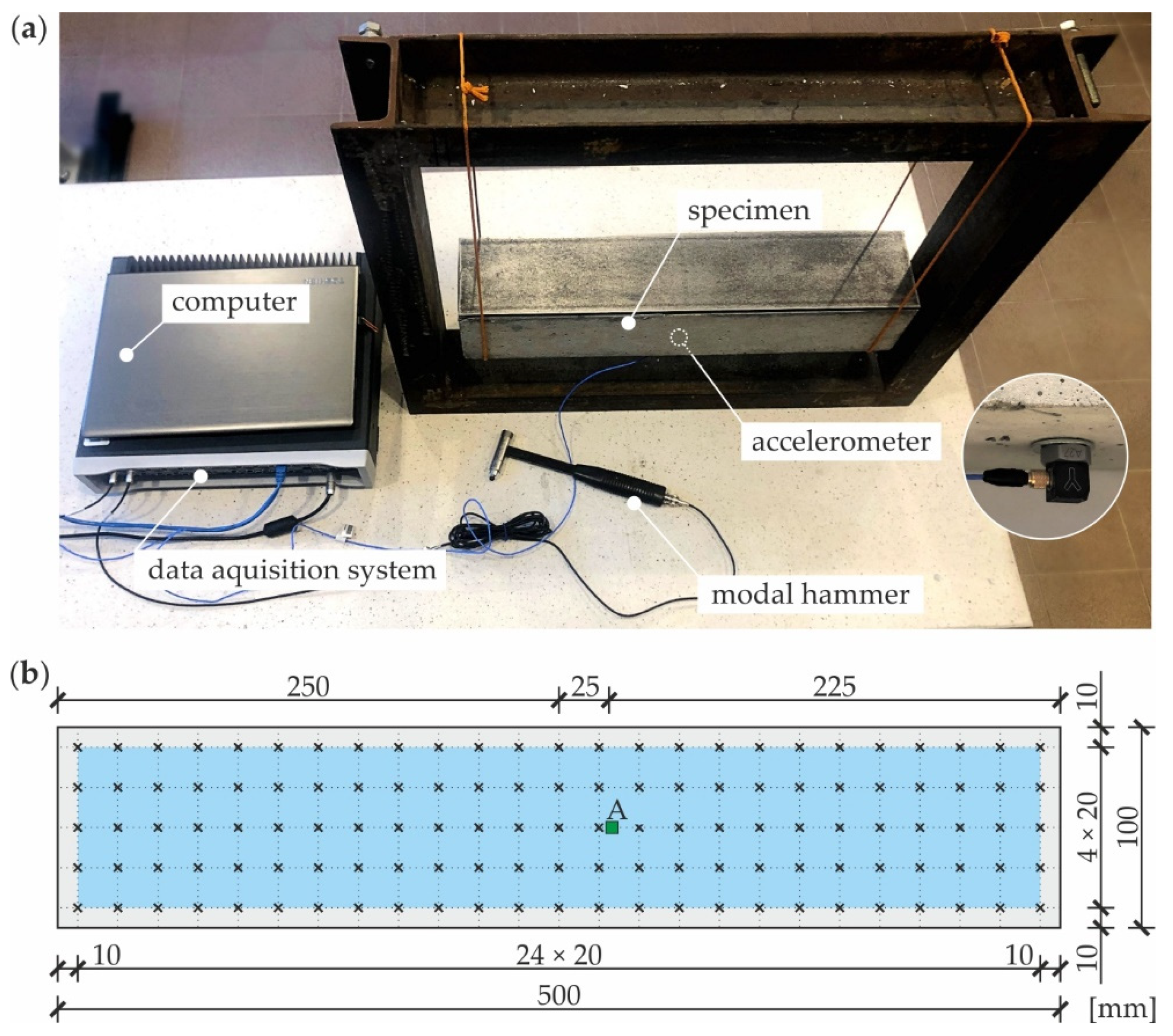

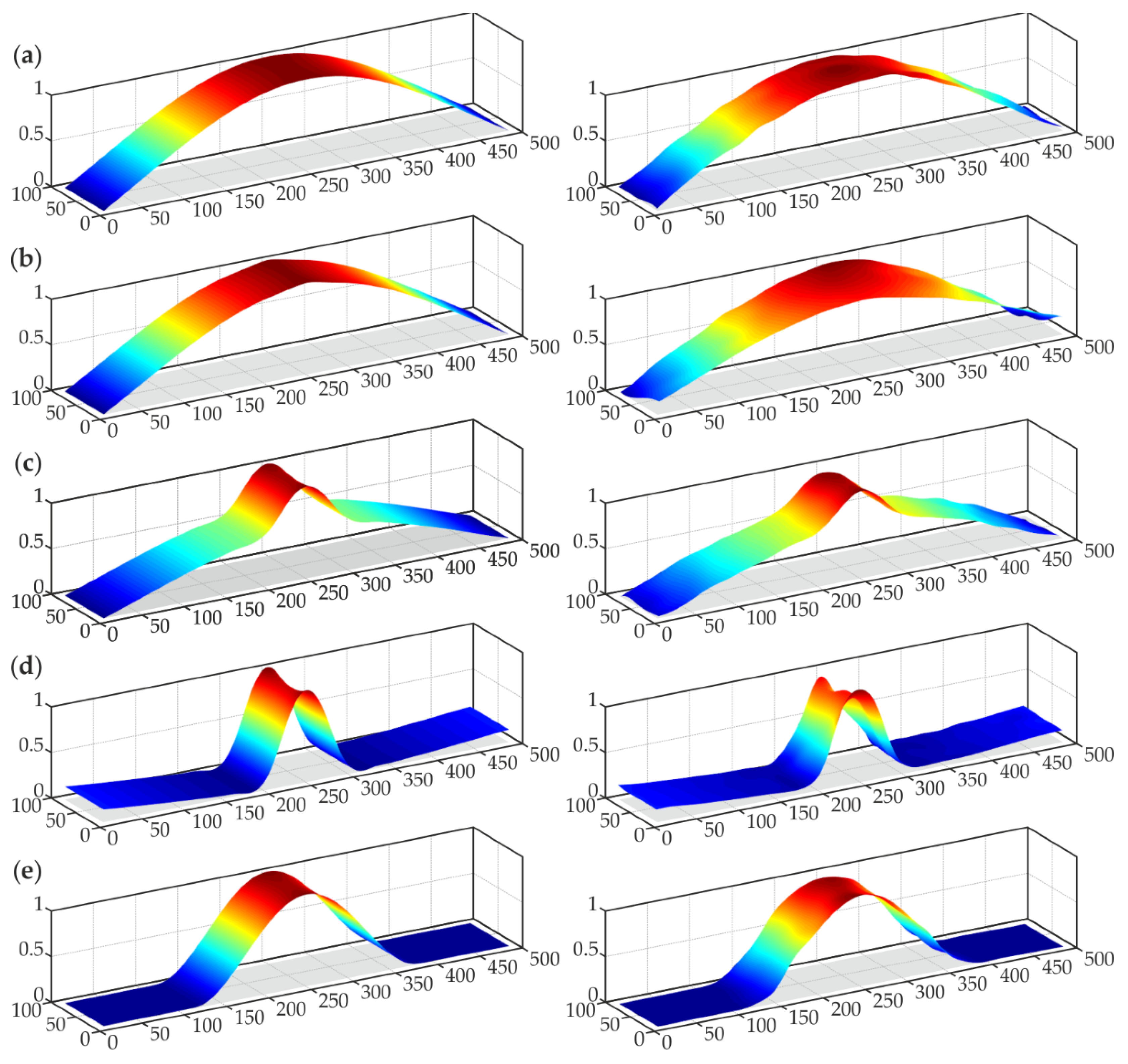

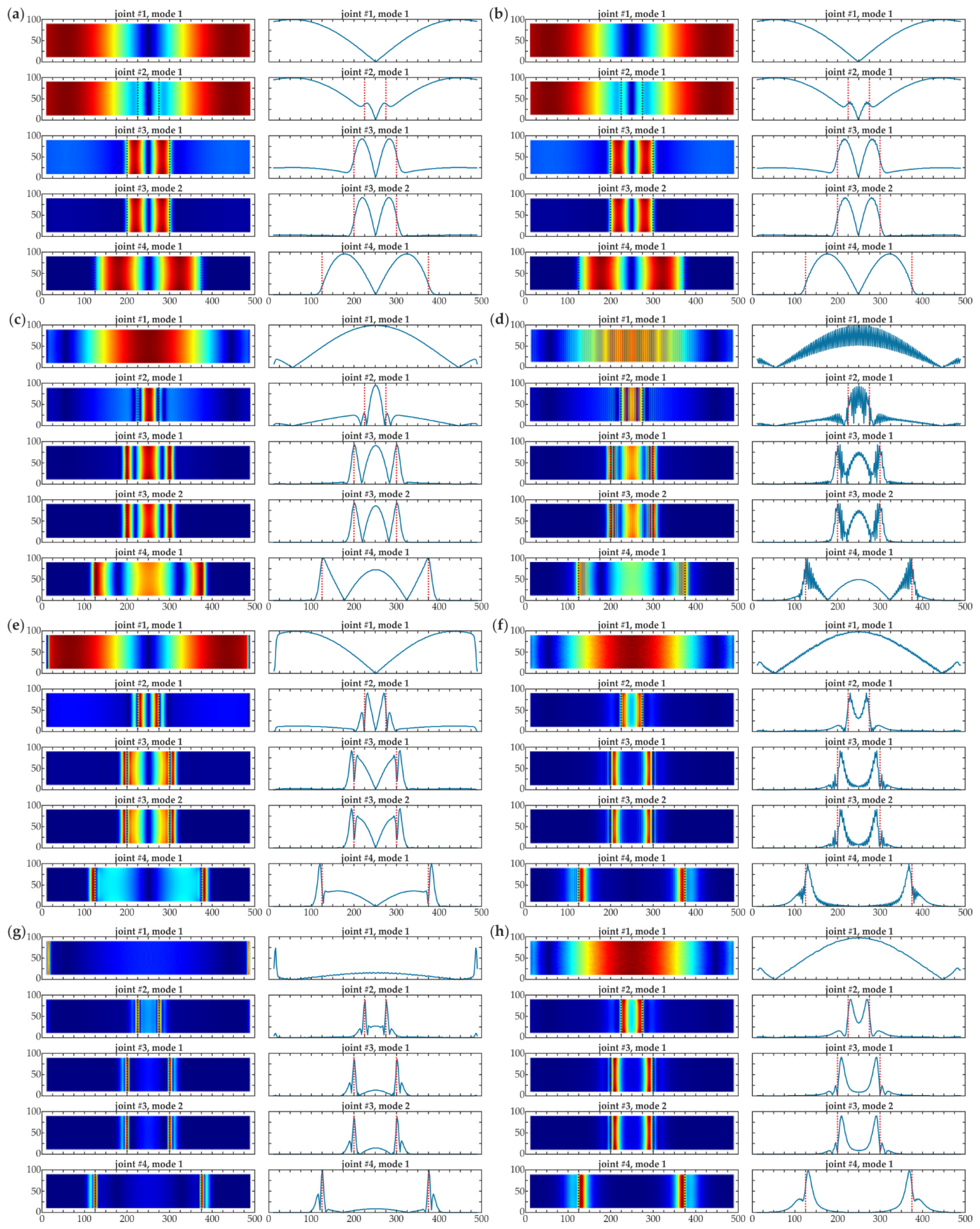
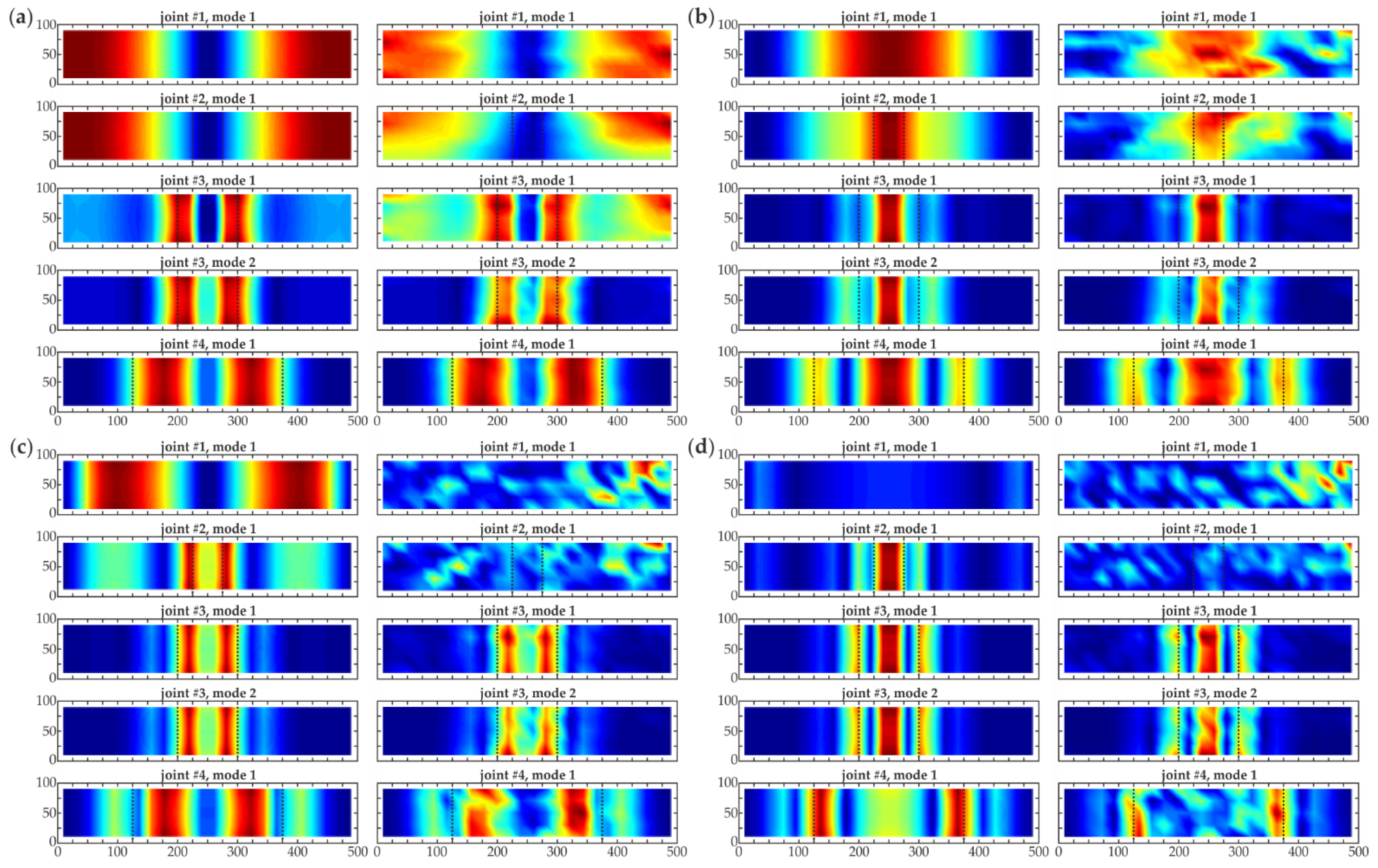

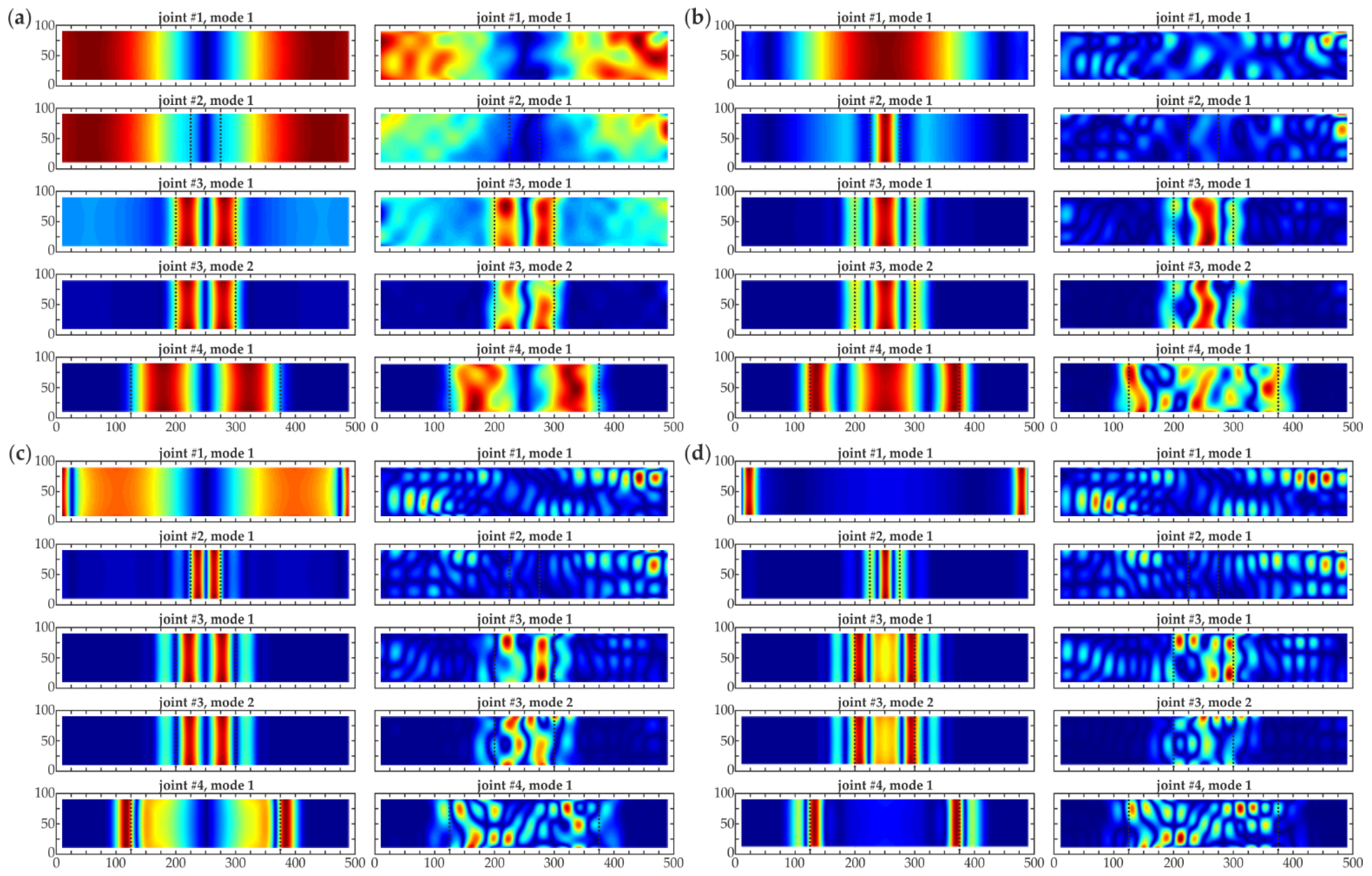

| Element | Material | Density ρ (kg/m3) | Elastic Modulus E (GPa) | Poisson’s Ratio ν (-) |
|---|---|---|---|---|
| Beam | Concrete | 2364.4 | 48.0 | 0.16 |
| Plate | Steel | 7579.0 | 200.3 | 0.30 |
| Film | Adhesive | 1611.8 | 12.5 | 0.30 |
| Sample | Mode | fnum (Hz) | fexp (Hz) | Δf (%) | MAC * (-) |
|---|---|---|---|---|---|
| #1 | 1 | 1899 | 1761 | 7.8 | 0.9991 |
| #2 | 1 | 1898 | 1751 | 8.4 | 0.9892 |
| #3 | 1 | 1859 | 1722 | 8.0 | 0.9899 |
| 2 | 2468 | 2436 | 1.3 | 0.9782 | |
| #4 | 1 | 453 | 476 | 4.8 | 0.9966 |
Publisher’s Note: MDPI stays neutral with regard to jurisdictional claims in published maps and institutional affiliations. |
© 2021 by the authors. Licensee MDPI, Basel, Switzerland. This article is an open access article distributed under the terms and conditions of the Creative Commons Attribution (CC BY) license (https://creativecommons.org/licenses/by/4.0/).
Share and Cite
Knak, M.; Wojtczak, E.; Rucka, M. Non-Destructive Diagnostics of Concrete Beams Strengthened with Steel Plates Using Modal Analysis and Wavelet Transform. Materials 2021, 14, 3014. https://doi.org/10.3390/ma14113014
Knak M, Wojtczak E, Rucka M. Non-Destructive Diagnostics of Concrete Beams Strengthened with Steel Plates Using Modal Analysis and Wavelet Transform. Materials. 2021; 14(11):3014. https://doi.org/10.3390/ma14113014
Chicago/Turabian StyleKnak, Magdalena, Erwin Wojtczak, and Magdalena Rucka. 2021. "Non-Destructive Diagnostics of Concrete Beams Strengthened with Steel Plates Using Modal Analysis and Wavelet Transform" Materials 14, no. 11: 3014. https://doi.org/10.3390/ma14113014
APA StyleKnak, M., Wojtczak, E., & Rucka, M. (2021). Non-Destructive Diagnostics of Concrete Beams Strengthened with Steel Plates Using Modal Analysis and Wavelet Transform. Materials, 14(11), 3014. https://doi.org/10.3390/ma14113014







